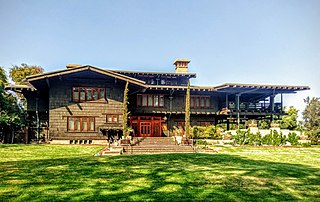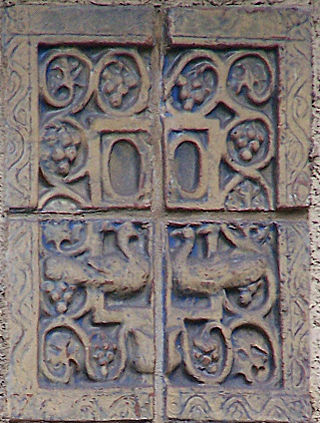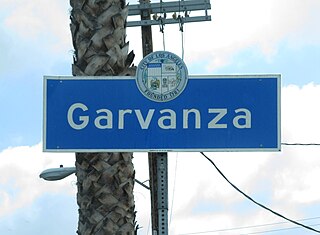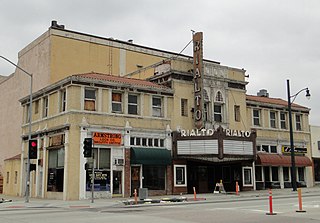
Pasadena is a city in Los Angeles County, California, United States, 11 miles (18 km) northeast of downtown Los Angeles. It is the most populous city and the primary cultural center of the San Gabriel Valley. Old Pasadena is the city's original commercial district.

The Arroyo Seco Parkway, also known as the Pasadena Freeway, is one of the oldest freeways in the United States. It connects Los Angeles with Pasadena alongside the Arroyo Seco seasonal river. Mostly opened in 1940, it represents the transitional phase between early parkways and later freeways. It conformed to modern standards when it was built, but is now regarded as a narrow, outdated roadway. A 1953 extension brought the south end to the Four Level Interchange in downtown Los Angeles and a connection with the rest of the freeway system.

Route 110, consisting of State Route 110 (SR 110) and Interstate 110 (I-110), is a state and auxiliary Interstate Highway in the Los Angeles metropolitan area of the US state of California. The entire route connects San Pedro and the Port of Los Angeles with Downtown Los Angeles and Pasadena. The southern segment from San Pedro to I-10 in downtown Los Angeles is signed as I-110, while the northern segment to Pasadena is signed as SR 110. The entire length of I-110, as well as SR 110 south of the Four Level Interchange with US Route 101 (US 101), is the Harbor Freeway, and SR 110 north from US 101 to Pasadena is the historic Arroyo Seco Parkway, the first freeway in the western United States.

The Gamble House, also known as the David B. Gamble House, is a historic American Craftsman home in Pasadena, California, designed by the architectural firm Greene and Greene. Constructed in 1908–1909 as a home for David B. Gamble, son of the Procter & Gamble founder James Gamble, it is today a National Historic Landmark, a California Historical Landmark, and open to the public for tours and events.

Highland Park is a neighborhood in Los Angeles, California, located in the city's Northeast region. It was one of the first subdivisions of Los Angeles and is inhabited by a variety of ethnic and socioeconomic groups.

The Arroyo Seco, meaning "dry stream" in Spanish, is a 24.9-mile-long (40.1 km) seasonal river, canyon, watershed, and cultural area in Los Angeles County, California. The area was explored by Gaspar de Portolà who named the stream Arroyo Seco as this canyon had the least water of any he had seen. During this exploration he met the Chief Hahamog-na (Hahamonga) of the Tongva Indians.

Ernest Allan Batchelder was an American artist and educator who made Southern California his home in the early 20th century. He created art tiles and was a leader in the American Arts and Crafts Movement.

The Batchelder House is a historic home built in 1910 and located at 626 South Arroyo Boulevard in Pasadena, California. An important center of Pasadena cultural life in its day, the home was designed and built by Ernest A. Batchelder, a prominent leader of the Arts and Crafts Movement, and his wife, Alice Coleman, an accomplished musician. The house, a large bungalow, has a "woodsy" design with elements of a Swiss chalet style. Batchelder's first craft shop was located in the structure, where decorative tiles were made for Greene and Greene, the Heineman Brothers, and other noted local architects of the era. Coleman also used the house's backyard stage to host chamber music concerts.

Garvanza is a neighborhood in northeast Los Angeles. Fourteen Los Angeles Historic-Cultural Monuments are located in the neighborhood.

The Drake Park Neighborhood Historic District is located adjacent to Drake Park near the historic downtown area in Bend, Oregon, United States. Because of the unique and varied architecture in the Drake Park neighborhood and its close association with the early development of the city of Bend, the area was listed on the National Register of Historic Places in 2005.
Lower Arroyo is a neighborhood in Pasadena, California, centered on the Arroyo Seco south of Brookside Park. It is bordered by Holly Street to the north, Columbia Street to the south, San Rafael Avenue to the west, and Orange Grove Boulevard to the east.

This is intended to be a complete list of the properties and districts on the National Register of Historic Places in the city of Pasadena, California, United States. The locations of National Register properties and districts for which the latitude and longitude coordinates are included below, may be seen in an online map.

The La Loma Bridge is a bridge that carries La Loma Road across the Arroyo Seco, located in Pasadena, California.

The Dr. W. T. Bolton House is a historic house located at 370 W. Del Mar Boulevard in Pasadena, California. Built in 1906, the Craftsman-style house was designed by prominent Pasadena architects Charles and Henry Greene. The house's design emphasizes function over form, a key concept in Craftsman designs; its joints and beams are exposed, and the wooden front door was oiled by hand to highlight its natural grain and color. The house's light fixtures, stained glass windows, and even furnishings were also designed by Greene and Greene to give the house a unified design. Dr. W. T. and Alice Bolton commissioned the house, which was their second residence designed by the Greene brothers; while W. T. Bolton died before he could live in the house, Alice Bolton lived there until 1917. The house was one of several Craftsman homes built in Pasadena's "Millionaire's Row" district, which included a number of large homes in the vicinity of Orange Grove Boulevard.

Prospect Historic District is a residential historic district in Pasadena, California, consisting of homes along Prospect Boulevard and several surrounding streets. The approximate northern boundary of the district is Westgate Street and the approximate southern boundary is Orange Grove Boulevard. The district includes 108 residences and roughly encompasses the Prospect Park and Arroyo Park Tracts, a pair of early Pasadena subdivisions.

The South Marengo Historic District is a residential historic district located along South Marengo Avenue in Pasadena, California. The district consists of twelve Craftsman-style bungalows situated on the two blocks between Bellevue Drive and California Boulevard. The homes were built from 1901 to 1916, at the height of the bungalow's popularity in Pasadena. Several prominent local architects designed the homes, including Louis B. Easton, planner of the homes at 530 and 540 South Marengo; Easton's work was featured in Gustav Stickley's magazine The Craftsman. Marengo Avenue was considered an upscale district of Pasadena at the time, partly due to its well-designed homes and partly due to the pepper trees planted along the street.

The Rialto Theatre is a 1,200-seat theater in South Pasadena, California. Located on Fair Oaks Avenue, it is considered one of the last single-screen theaters in Southern California and is listed on the National Register of Historic Places.

The Park Place–Arroyo Terrace Historic District is a residential historic district located in northwest Pasadena, California. The district includes eleven contributing houses built from 1902 to 1912. Most of the houses in the district were influenced by the Arts and Crafts Movement, which was popular in Pasadena in the early 20th century; particular styles in the district include the American Craftsman house, the Craftsman bungalow, the Colonial Revival house, and the Prairie School house. Prominent Pasadena architects Charles and Henry Greene designed seven of the district's houses; the district is the most concentrated collection of their works in Pasadena. Two other noted Craftsman architects, Myron Hunt and Sylvanus Marston, also designed homes in the district, including Hunt's own residence.

The Henry Levy House at 155 S. G Street is a historic American Craftsman home located in Oxnard, California. The house has 18 rooms with five bedrooms and five bathrooms, a detached two-car garage, and a detached workshop in the rear. It is approximately 5,200 square feet (480 m2) and sits on three parcels of land totaling nearly 21,000 square feet (2,000 m2).

The Kenneth Newell Bikeway in Pasadena is one of the first bike paths established in Los Angeles County. This “popular, well-marked bikeway” has been called “one of the premier inland trips.” The path travels through the canyon of the Arroyo Seco river, a tributary of the Los Angeles River.

























